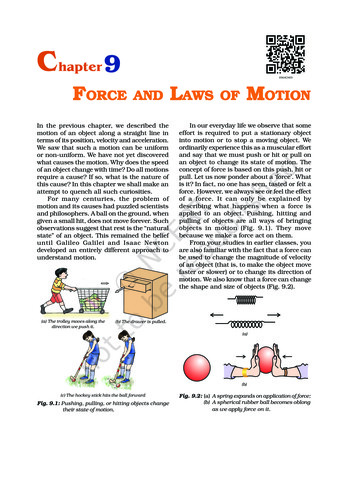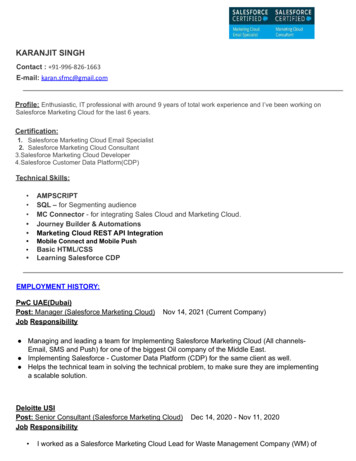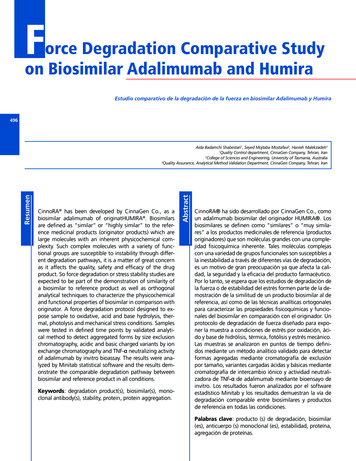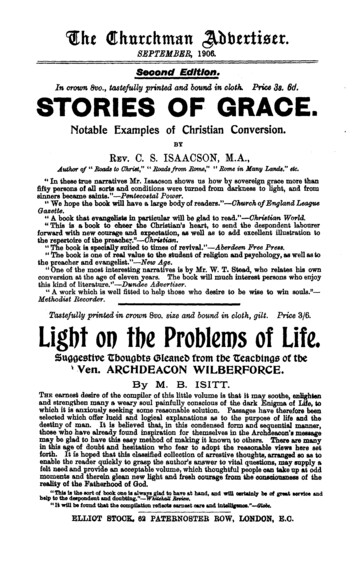
Transcription
Chapter 9FORCEANDIn the previous chapter, we described themotion of an object along a straight line interms of its position, velocity and acceleration.We saw that such a motion can be uniformor non-uniform. We have not yet discoveredwhat causes the motion. Why does the speedof an object change with time? Do all motionsrequire a cause? If so, what is the nature ofthis cause? In this chapter we shall make anattempt to quench all such curiosities.For many centuries, the problem ofmotion and its causes had puzzled scientistsand philosophers. A ball on the ground, whengiven a small hit, does not move forever. Suchobservations suggest that rest is the “naturalstate” of an object. This remained the beliefuntil Galileo Galilei and Isaac Newtondeveloped an entirely different approach tounderstand motion.(a) The trolley moves along thedirection we push it.LAWSOFMOTIONIn our everyday life we observe that someeffort is required to put a stationary objectinto motion or to stop a moving object. Weordinarily experience this as a muscular effortand say that we must push or hit or pull onan object to change its state of motion. Theconcept of force is based on this push, hit orpull. Let us now ponder about a ‘force’. Whatis it? In fact, no one has seen, tasted or felt aforce. However, we always see or feel the effectof a force. It can only be explained bydescribing what happens when a force isapplied to an object. Pushing, hitting andpulling of objects are all ways of bringingobjects in motion (Fig. 9.1). They movebecause we make a force act on them.From your studies in earlier classes, youare also familiar with the fact that a force canbe used to change the magnitude of velocityof an object (that is, to make the object movefaster or slower) or to change its direction ofmotion. We also know that a force can changethe shape and size of objects (Fig. 9.2).(b) The drawer is pulled.(a)(b)(c) The hockey stick hits the ball forwardFig. 9.1: Pushing, pulling, or hitting objects changetheir state of motion.Fig. 9.2: (a) A spring expands on application of force;(b) A spherical rubber ball becomes oblongas we apply force on it.
9.1 Balanced and UnbalancedForcesFig. 9.3 shows a wooden block on a horizontaltable. Two strings X and Y are tied to the twoopposite faces of the block as shown. If weapply a force by pulling the string X, the blockbegins to move to the right. Similarly, if wepull the string Y, the block moves to the left.But, if the block is pulled from both the sideswith equal forces, the block will not move.Such forces are called balanced forces anddo not change the state of rest or of motion ofan object. Now, let us consider a situation inwhich two opposite forces of differentmagnitudes pull the block. In this case, theblock would begin to move in the direction ofthe greater force. Thus, the two forces arenot balanced and the unbalanced force actsin the direction the block moves. Thissuggests that an unbalanced force acting onan object brings it in motion.Fig. 9.3: Two forces acting on a wooden blockWhat happens when some children try topush a box on a rough floor? If they push the(a)box with a small force, the box does not movebecause of friction acting in a directionopposite to the push [Fig. 9.4(a)]. This frictionforce arises between two surfaces in contact;in this case, between the bottom of the boxand floor’s rough surface. It balances thepushing force and therefore the box does notmove. In Fig. 9.4(b), the children push thebox harder but the box still does not move.This is because the friction force still balancesthe pushing force. If the children push thebox harder still, the pushing force becomesbigger than the friction force [Fig. 9.4(c)].There is an unbalanced force. So the boxstarts moving.What happens when we ride a bicycle?When we stop pedalling, the bicycle beginsto slow down. This is again because of thefriction forces acting opposite to the directionof motion. In order to keep the bicycle moving,we have to start pedalling again. It thusappears that an object maintains its motionunder the continuous application of anunbalanced force. However, it is quiteincorrect. An object moves with a uniformvelocity when the forces (pushing force andfrictional force) acting on the object arebalanced and there is no net external forceon it. If an unbalanced force is applied onthe object, there will be a change either in itsspeed or in the direction of its motion. Thus,to accelerate the motion of an object, anunbalanced force is required. And the changein its speed (or in the direction of motion)would continue as long as this unbalancedforce is applied. However, if this force is(b)(c)Fig. 9.4FORCEANDLAWSOFMOTION115
removed completely, the object wouldcontinue to move with the velocity it hasacquired till then.9.2 First Law of MotionBy observing the motion of objects on aninclined plane Galileo deduced that objectsmove with a constant speed when no forceacts on them. He observed that when a marblerolls down an inclined plane, its velocityincreases [Fig. 9.5(a)]. In the next chapter,you will learn that the marble falls under theunbalanced force of gravity as it rolls downand attains a definite velocity by the time itreaches the bottom. Its velocity decreaseswhen it climbs up as shown in Fig. 9.5(b).Fig. 9.5(c) shows a marble resting on an idealfrictionless plane inclined on both sides.Galileo argued that when the marble isreleased from left, it would roll down the slopeand go up on the opposite side to the sameheight from which it was released. If theinclinations of the planes on both sides areequal then the marble will climb the samedistance that it covered while rolling down. Ifthe angle of inclination of the right-side planewere gradually decreased, then the marblewould travel further distances till it reachesthe original height. If the right-side plane wereultimately made horizontal (that is, the slopeis reduced to zero), the marble would continueto travel forever trying to reach the sameheight that it was released from. Theunbalanced forces on the marble in this caseare zero. It thus suggests that an unbalanced(external) force is required to change themotion of the marble but no net force isneeded to sustain the uniform motion of themarble. In practical situations it is difficultto achieve a zero unbalanced force. This isbecause of the presence of the frictional forceacting opposite to the direction of motion.Thus, in practice the marble stops aftertravelling some distance. The effect of thefrictional force may be minimised by using asmooth marble and a smooth plane andproviding a lubricant on top of the planes.116Fig. 9.5: (a) the downward motion; (b) the upwardmotion of a marble on an inclined plane;and (c) on a double inclined plane.Newton further studied Galileo’s ideas onforce and motion and presented threefundamental laws that govern the motion ofobjects. These three laws are known asNewton’s laws of motion. The first law ofmotion is stated as:An object remains in a state of rest or ofuniform motion in a straight line unlesscompelled to change that state by an appliedforce.In other words, all objects resist a changein their state of motion. In a qualitative way,the tendency of undisturbed objects to stayat rest or to keep moving with the samevelocity is called inertia. This is why, the firstlaw of motion is also known as the law ofinertia.Certain experiences that we come acrosswhile travelling in a motorcar can beexplained on the basis of the law of inertia.We tend to remain at rest with respect to theseat until the driver applies a braking forceto stop the motorcar. With the application ofbrakes, the car slows down but our bodytends to continue in the same state of motionbecause of its inertia. A sudden applicationof brakes may thus cause injury to us bySCIENCE
Galileo Galilei was bornon 15 February 1564 inPisa, Italy. Galileo, rightfrom his childhood, hadinterest in mathematicsand natural philosophy.ButhisfatherVincenzo Galilei wantedhim to become a medicaldoctor.Accordingly,Galileo GalileiGalileo enrolled himself(1564 – 1642)for a medical degree at theUniversity of Pisa in 1581 which he nevercompleted because of his real interest inmathematics. In 1586, he wrote his firstscientific book ‘The Little Balance [LaBalancitta]’, in which he describedArchimedes’ method of finding the relativedensities (or specific gravities) of substancesusing a balance. In 1589, in his series ofessays – De Motu, he presented his theoriesabout falling objects using an inclined planeto slow down the rate of descent.In 1592, he was appointed professor ofmathematics at the University of Padua inthe Republic of Venice. Here he continued hisobservations on the theory of motion andthrough his study of inclined planes and thependulum, formulated the correct law foruniformly accelerated objects that thedistance the object moves is proportional tothe square of the time taken.Galileo was also a remarkable craftsman.He developed a series of telescopes whoseoptical performance was much better thanthat of other telescopes available during thosedays. Around 1640, he designed the firstpendulum clock. In his book ‘StarryMessenger’ on his astronomical discoveries,Galileo claimed to have seen mountains onthe moon, the milky way made up of tinystars, and four small bodies orbiting Jupiter.In his books ‘Discourse on Floating Bodies’and ‘Letters on the Sunspots’, he disclosedhis observations of sunspots.Using his own telescopes and through hisobservations on Saturn and Venus, Galileoargued that all the planets must orbit the Sunand not the earth, contrary to what wasbelieved at that time.FORCEANDLAWSOFMOTIONimpact or collision with the panels in front.Safety belts are worn to prevent suchaccidents. Safety belts exert a force on ourbody to make the forward motion slower. Anopposite experience is encountered when weare standing in a bus and the bus begins tomove suddenly. Now we tend to fallbackwards. This is because the sudden startof the bus brings motion to the bus as wellas to our feet in contact with the floor of thebus. But the rest of our body opposes thismotion because of its inertia.When a motorcar makes a sharp turn ata high speed, we tend to get thrown to oneside. This can again be explained on the basisof the law of inertia. We tend to continue inour straight-line motion. When anunbalanced force is applied by the engine tochange the direction of motion of themotorcar, we slip to one side of the seat dueto the inertia of our body.The fact that a body will remain at restunless acted upon by an unbalanced forcecan be illustrated through the followingactivities:Activity 9.1 Make a pile of similar carom coins ona table, as shown in Fig. 9.6.Attempt a sharp horizontal hit at thebottom of the pile using another caromcoin or the striker. If the hit is strongenough, the bottom coin moves outquickly. Once the lowest coin isremoved, the inertia of the other coinsmakes them ‘fall’ vertically on the table.Fig. 9.6: Only the carom coin at the bottom of apile is removed when a fast moving caromcoin (or striker) hits it.117
Activity 9.2 Set a five-rupee coin on a stiff cardcovering an empty glass tumblerstanding on a table as shown inFig. 9.7.Give the card a sharp horizontal flickwith a finger. If we do it fast then thecard shoots away, allowing the coin tofall vertically into the glass tumbler dueto its inertia.The inertia of the coin tries to maintainits state of rest even when the cardflows off.Fig. 9.7: When the card is flicked with thefinger the coin placed over it falls in thetumbler.Activity 9.3 Place a water-filled tumbler on a tray.Hold the tray and turn around as fastas you can.We observe that the water spills. Why?Observe that a groove is provided in asaucer for placing the tea cup. It preventsthe cup from toppling over in case of suddenjerks.9.3 Inertia and MassAll the examples and activities given so farillustrate that there is a resistance offered byan object to change its state of motion. If it isat rest it tends to remain at rest; if it is movingit tends to keep moving. This property of anobject is called its inertia. Do all bodies havethe same inertia? We know that it is easier topush an empty box than a box full of books.Similarly, if we kick a football it flies away.But if we kick a stone of the same size withequal force, it hardly moves. We may, in fact,get an injury in our foot while doing so!Similarly, in activity 9.2, instead of a118five-rupees coin if we use a one-rupee coin, wefind that a lesser force is required to performthe activity. A force that is just enough tocause a small cart to pick up a large velocitywill produce a negligible change in the motionof a train. This is because, in comparison tothe cart the train has a much lesser tendencyto change its state of motion. Accordingly, wesay that the train has more inertia than thecart. Clearly, heavier or more massive objectsoffer larger inertia. Quantitatively, the inertiaof an object is measured by its mass. We maythus relate inertia and mass as follows:Inertia is the natural tendency of an object toresist a change in its state of motion or ofrest. The mass of an object is a measure ofits inertia.Questions1. Which of the following has moreinertia: (a) a rubber ball and astone of the same size? (b) abicycle and a train? (c) a fiverupees coin and a one-rupee coin?2. In the following example, try toidentify the number of times thevelocity of the ball changes:“A football player kicks a footballto another player of his team whokicks the football towards thegoal. The goalkeeper of theopposite team collects the footballand kicks it towards a player ofhis own team”.Also identify the agent supplyingthe force in each case.3. Explain why some of the leavesmay get detached from a tree ifwe vigorously shake its branch.4. Why do you fall in the forwarddirection when a moving busbrakes to a stop and fallbackwards when it acceleratesfrom rest?9.4 Second Law of MotionThe first law of motion indicates that whenan unbalanced external force acts on anSCIENCE
object, its velocity changes, that is, the objectgets an acceleration. We would now like tostudy how the acceleration of an objectdepends on the force applied to it and howwe measure a force. Let us recount someobservations from our everyday life. Duringthe game of table tennis if the ball hits a playerit does not hurt him. On the other hand, whena fast moving cricket ball hits a spectator, itmay hurt him. A truck at rest does not requireany attention when parked along a roadside.But a moving truck, even at speeds as low as5 m s–1, may kill a person standing in its path.A small mass, such as a bullet may kill aperson when fired from a gun. Theseobservations suggest that the impactproduced by the objects depends on theirmass and velocity. Similarly, if an object is tobe accelerated, we know that a greater forceis required to give a greater velocity. In otherwords, there appears to exist some quantityof importance that combines the object’smass and its velocity. One such propertycalled momentum was introduced by Newton.The momentum, p of an object is defined asthe product of its mass, m and velocity, v.That is,p mv(9.1)Momentum has both direction andmagnitude. Its direction is the same as thatof velocity, v. The SI unit of momentum iskilogram-metre per second (kg m s-1). Sincethe application of an unbalanced force bringsa change in the velocity of the object, it istherefore clear that a force also produces achange of momentum.Let us consider a situation in which a carwith a dead battery is to be pushed along astraight road to give it a speed of 1 m s-1,which is sufficient to start its engine. If oneor two persons give a sudden push(unbalanced force) to it, it hardly starts. Buta continuous push over some time results ina gradual acceleration of the car to this speed.It means that the change of momentum ofthe car is not only determined by themagnitude of the force but also by the timeduring which the force is exerted. It may thenalso be concluded that the force necessary toFORCEANDLAWSOFMOTIONchange the momentum of an object dependson the time rate at which the momentum ischanged.The second law of motion states that therate of change of momentum of an object isproportional to the applied unbalanced forcein the direction of force.9.4.1 MATHEMATICALFORMULATION OFSECOND LAW OF MOTIONSuppose an object of mass, m is moving alonga straight line with an initial velocity, u. It isuniformly accelerated to velocity, v in time, tby the application of a constant force, Fthroughout the time, t. The initial and finalmomentum of the object will be, p1 mu andp2 mv respectively.The change in momentum p2 – p1 mv – mu m (v – u).The rate of change of momentum m (v u )tOr, the applied force,F m (v u )tkm (v u )t kmaF (9.2)(9.3)Here a [ (v – u)/t ] is the acceleration,which is the rate of change of velocity. Thequantity, k is a constant of proportionality.The SI units of mass and acceleration are kgand m s-2 respectively. The unit of force is sochosen that the value of the constant, kbecomes one. For this, one unit of force isdefined as the amount that produces anacceleration of 1 m s-2 in an object of 1 kgmass. That is,1 unit of force k (1 kg) (1 m s-2).Thus, the value of k becomes 1. From Eq. (9.3)(9.4)F ma-2The unit of force is kg m s or newton,which has the symbol N. The second law of119
motion gives us a method to measure theforce acting on an object as a product of itsmass and acceleration.The second law of motion is often seen inaction in our everyday life. Have you noticedthat while catching a fast moving cricket ball,a fielder in the ground gradually pulls hishands backwards with the moving ball? Indoing so, the fielder increases the time duringwhich the high velocity of the moving balldecreases to zero. Thus, the acceleration ofthe ball is decreased and therefore the impactof catching the fast moving ball (Fig. 9.8) isalso reduced. If the ball is stopped suddenlythen its high velocity decreases to zero in avery short interval of time. Thus, the rate ofchange of momentum of the ball will be large.Therefore, a large force would have to beapplied for holding the catch that may hurtthe palm of the fielder. In a high jump athleticevent, the athletes are made to fall either ona cushioned bed or on a sand bed. This is toincrease the time of the athlete’s fall to stopafter making the jump. This decreases therate of change of momentum and hence theforce. Try to ponder how a karate playerbreaks a slab of ice with a single blow.The first law of motion can bemathematically stated from the mathematicalexpression for the second law of motion. Eq.(9.4) isF maororF m (v u )(9.5)tFt mv – muThat is, when F 0, v u for whatever time,t is taken. This means that the object willcontinue moving with uniform velocity, uthroughout the time, t. If u is zero then v willalso be zero. That is, the object will remainat rest.Example 9.1 A constant force acts on anobject of mass 5 kg for a duration of2 s. It increases the object’s velocityfrom 3 m s–1 to 7 m s -1. Find themagnitude of the applied force. Now, ifthe force was applied for a duration of5 s, what would be the final velocity ofthe object?Solution:We have been given that u 3 m s–1and v 7 m s-1, t 2 s and m 5 kg.From Eq. (9.5) we have,F m (v u )tSubstitution of values in this relationgivesF 5 kg (7 m s-1 – 3 m s-1)/2 s 10 N.Now, if this force is applied for aduration of 5 s (t 5 s), then the finalvelocity can be calculated by rewritingEq. (9.5) asv u Fig. 9.8: A fielder pulls his hands gradually with themoving ball while holding a catch.120FtmOn substituting the values of u, F, mand t, we get the final velocity,v 13 m s-1.SCIENCE
Example 9.2 Which would require agreater force –– accelerating a 2 kg massat 5 m s–2 or a 4 kg mass at 2 m s-2 ?Solution:From Eq. (9.4), we have F ma.Here we have m1 2 kg; a1 5 m s-2and m2 4 kg; a2 2 m s-2.Thus, F1 m1a1 2 kg 5 m s-2 10 N;and F2 m2a2 4 kg 2 m s-2 8 N. F1 F2.Thus, accelerating a 2 kg mass at5 m s-2 would require a greater force.Example 9.3 A motorcar is moving with avelocity of 108 km/h and it takes 4 s tostop after the brakes are applied.Calculate the force exerted by thebrakes on the motorcar if its mass alongwith the passengers is 1000 kg.Solution:From Eq. (9.4) we have m1 F/a1; andm2 F/a2. Here, a1 10 m s-2;a2 20 m s-2 and F 5 N.Thus, m1 5 N/10 m s-2 0.50 kg; andm2 5 N/20 m s-2 0.25 kg.If the two masses were tied together,the total mass, m would bem 0.50 kg 0.25 kg 0.75 kg.The acceleration, a produced in thecombined mass by the 5 N force wouldbe, a F/m 5 N/0.75 kg 6.67 m s-2.Example 9.5 The velocity-time graph of aball of mass 20 g moving along astraight line on a long table is given inFig. 9.9.Solution:The initial velocity of the motorcaru 108 km/h 108 1000 m/(60 60 s) 30 m s-1and the final velocity of the motorcarv 0 m s-1.The total mass of the motorcar alongwith its passengers 1000 kg and thetime taken to stop the motorcar, t 4 s.From Eq. (9.5) we have the magnitudeof the force (F) applied by the brakes asm(v – u)/t.On substituting the values, we getF 1000 kg (0 – 30) m s-1/4 s – 7500 kg m s-2 or – 7500 N.The negative sign tells us that the forceexerted by the brakes is opposite to thedirection of motion of the motorcar.Example 9.4 A force of 5 N gives a massm1, an acceleration of 10 m s–2 and amass m2, an acceleration of 20 m s-2.What acceleration would it give if boththe masses were tied together?FORCEANDLAWSOFMOTIONFig. 9.9How much force does the table exerton the ball to bring it to rest?Solution:The initial velocity of the ball is 20 cm s-1.Due to the frictional force exerted by thetable, the velocity of the ball decreasesdown to zero in 10 s. Thus, u 20 cm s–1;v 0 cm s-1 and t 10 s. Since thevelocity-time graph is a straight line, it isclear that the ball moves with a constantacceleration. The acceleration a isv ut (0 cm s-1 – 20 cm s-1)/10 s –2 cm s-2 –0.02 m s-2.a 121
The force exerted on the ball F is,F ma (20/1000) kg (– 0.02 m s-2) – 0.0004 N.The negative sign implies that thefrictional force exerted by the table isopposite to the direction of motion ofthe ball.9.5 Third Law of MotionThe first two laws of motion tell us how anapplied force changes the motion and provideus with a method of determining the force.The third law of motion states that when oneobject exerts a force on another object, thesecond object instantaneously exerts a forceback on the first. These two forces are alwaysequal in magnitude but opposite in direction.These forces act on different objects and neveron the same object. In the game of footballsometimes we, while looking at the footballand trying to kick it with a greater force,collide with a player of the opposite team.Both feel hurt because each applies a forceto the other. In other words, there is a pair offorces and not just one force. The twoopposing forces are also known as action andreaction forces.Let us consider two spring balancesconnected together as shown in Fig. 9.10. Thefixed end of balance B is attached with a rigidsupport, like a wall. When a force is appliedthrough the free end of spring balance A, it isobserved that both the spring balances showthe same readings on their scales. It meansthat the force exerted by spring balance A onbalance B is equal but opposite in directionto the force exerted by the balance B onbalance A. Any of these two forces can be calledas action and the other as reaction. This givesus an alternative statement of the third law ofmotion i.e., to every action there is an equaland opposite reaction. However, it must beremembered that the action and reactionalways act on two different objects,simultaneously.122Fig. 9.10: Action and reaction forces are equal andopposite.Suppose you are standing at rest andintend to start walking on a road. You mustaccelerate, and this requires a force inaccordance with the second law of motion.Which is this force? Is it the muscular effortyou exert on the road? Is it in the directionwe intend to move? No, you push the roadbelow backwards. The road exerts an equaland opposite force on your feet to make youmove forward.It is important to note that even thoughthe action and reaction forces are alwaysequal in magnitude, these forces may notproduce accelerations of equal magnitudes.This is because each force acts on a differentobject that may have a different mass.When a gun is fired, it exerts a forwardforce on the bullet. The bullet exerts an equaland opposite force on the gun. This results inthe recoil of the gun (Fig. 9.11). Since the gunhas a much greater mass than the bullet, theacceleration of the gun is much less than theacceleration of the bullet. The third law ofmotion can also be illustrated when a sailorjumps out of a rowing boat. As the sailorjumps forward, the force on the boat moves itbackwards (Fig. 9.12).Fig. 9.11: A forward force on the bullet and recoil ofthe gun.SCIENCE
The cart shown in this activity can beconstructed by using a 12 mm or 18 mm thickplywood board of about 50 cm 100 cm withtwo pairs of hard ball-bearing wheels (skatewheels are good to use). Skateboards are notas effective because it is difficult to maintainstraight-line motion.9.6 Conservation of MomentumFig. 9.12: As the sailor jumps in forward direction,the boat moves backwards.Activity 9.4 Request two children to stand on twoseparate carts as shown in Fig. 9.13.Give them a bag full of sand or someother heavy object. Ask them to play agame of catch with the bag.Does each of them experience aninstantaneous force as a result ofthrowing the sand bag?You can paint a white line oncartwheels to observe the motion of thetwo carts when the children throw thebag towards each other.Suppose two objects (two balls A and B, say)of masses mA and mB are travelling in the samedirection along a straight line at differentvelocities uA and uB, respectively [Fig. 9.14(a)].And there are no other external unbalancedforces acting on them. Let uA uB and thetwo balls collide with each other as shown inFig. 9.14(b). During collision which lasts fora time t, the ball A exerts a force FAB on ball Band the ball B exerts a force FBA on ball A.Suppose vA and vB are the velocities of thetwo balls A and B after the collision,respectively [Fig. 9.14(c)].Fig. 9.14: Conservation of momentum in collision oftwo balls.From Eq. (9.1), the momenta (plural ofmomentum) of ball A before and after thecollision are mAuA and mAvA, respectively. Therate of change of its momentum (or FAB)during the collision will be m AFig. 9.13Now, place two children on one cart andone on another cart. The second law of motioncan be seen, as this arrangement would showdifferent accelerations for the same force.FORCEANDLAWSOFMOTION(v A u A )t.Similarly, the rate of change of momentum ofball B ( FBA) during the collision will bemB(v B u B )t.According to the third law of motion,the force FAB exerted by ball A on ball B123
and the force FBA exerted by the ball B on ballA must be equal and opposite to each other.Therefore,FAB – FBA(9.6)mAor(v A u A )t – mB(v B u B ).tActivity 9.6 This gives,mAuA mBuB mAvA mBvB(9.7)Since (mAuA mBuB) is the total momentumof the two balls A and B before the collisionand (mAvA mBvB) is their total momentumafter the collision, from Eq. (9.7) we observethat the total momentum of the two ballsremains unchanged or conserved provided noother external force acts.As a result of this ideal collisionexperiment, we say that the sum of momentaof the two objects before collision is equal tothe sum of momenta after the collisionprovided there is no external unbalancedforce acting on them. This is known as thelaw of conservation of momentum. Thisstatement can alternatively be given as thetotal momentum of the two objects isunchanged or conserved by the collision. Take a test tube of good quality glassmaterial and put a small amount ofwater in it. Place a stop cork at themouth of it.Now suspend the test tube horizontallyby two strings or wires as shown inFig. 9.16.Heat the test tube with a burner untilwater vaporises and the cork blows out.Observe that the test tube recoils inthe direction opposite to the directionof the cork.Activity 9.5 Take a big rubber balloon and inflateit fully. Tie its neck using a thread. Alsousing adhesive tape, fix a straw on thesurface of this balloon.Pass a thread through the straw andhold one end of the thread in your handor fix it on the wall.Ask your friend to hold the other endof the thread or fix it on a wall at somedistance. This arrangement is shownin Fig. 9.15.Now remove the thread tied on the neckof balloon. Let the air escape from themouth of the balloon.Observe the direction in which thestraw moves.Fig. 9.15124Fig. 9.16 Also, observe the difference in thevelocity the cork appears to have andthat of the recoiling test tube.Example 9.6 A bullet of mass 20 g ishorizontally fired with a velocity150 m s-1 from a pistol of mass 2 kg.What is the recoil velocity of the pistol?Solution:We have the mass of bullet,m1 20 g ( 0.02 kg) and the mass ofthe pistol, m2 2 kg; initial velocities ofthe bullet (u 1) and pistol (u 2) 0,respectively. The final velocity of thebullet, v1 150 m s-1. The directionof bullet is taken from left to right(positive, by convention, Fig. 9.17). Letv be the recoil velocity of the pistol.SCIENCE
Total momenta of the pistol and bulletbefore the fire, when the gun is at rest (2 0.02) kg 0 m s–1 0 kg m s–1Total momenta of the pistol and bulletafter it is fired 0.02 kg ( 150 m s–1) 2 kg v m s–1 (3 2v) kg m s–1According to the law of conservation ofmomentumTotal momenta after the fire Totalmomenta before the fire3 2v 0 v 1.5 m s–1.Negative sig
Fig. 9.5: (a) the downward motion; (b) the upward motion of a marble on an inclined plane; and (c) on a double inclined plane. Newton further studied Galileo's ideas on force and motion and presented three fundamental laws that govern the motion of objects. These three laws are known as Newton's laws of motion. The first law of motion is .






